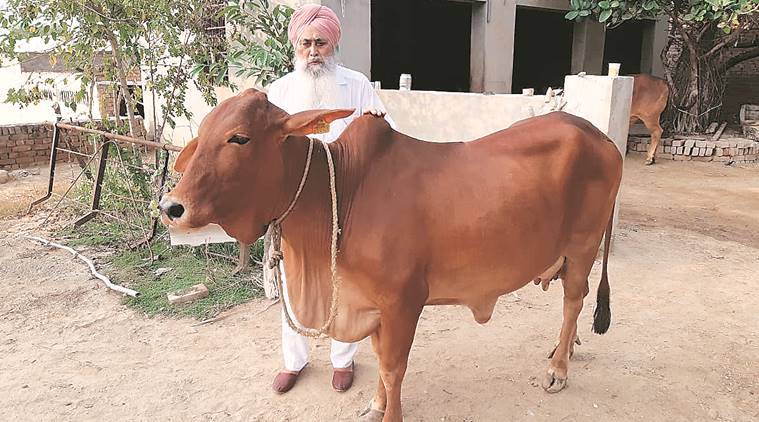
This Punjab Farmer Rakes in Rs 2.1 lakh from Sahiwal Cow Sale
The 70-year-old had, about 10 years back, bought a Sahiwal cow for Rs 4,000 and she gave birth to a female calf that was named Rani. Rani — her mother died soon after from a severe mastitis infection causing udder inflammation — went on to deliver four female calves, the eldest of them being Lakshmi. The seven-year-old Rani is now pregnant for the fifth time, while Lakshmi had produced one male calf (who has been kept in Hayer’s farm) and was expecting again when she was sold to NDDB.
“From a single cow bought 10 years ago, I have bred six animals, all of them through artificial insemination. They are all Sahiwal cattle. The good price that I have received for Lakshmi is prompting me to take up breeding in a more aggressive and focused way. I used to breed horses at one time, but this is something more satisfying and worthwhile,” notes Hayer, who grows cotton, paddy and wheat on 62 acres and eucalyptus trees (for supplying to plywood units) on his remaining 10 acres.
The Sahiwal breed, which originated in the Montgomery region of undivided India, is mainly native to southwest Punjab and the adjoining Sri Ganganagar district of north Rajasthan. Like all indigenous cows, its age at first calving is 3-3.5 years, compared to 2-2.5 years for exotic/crossbred animals. But Sahiwal cow is a relatively good milker, with average yields of 2,300-2,500 litres per lactation cycle, compared to 1,600-1,800 litres for other desi breeds such as Gir and Red Sindhi, 4,000-4,500 litres for crossbreds, and 6,000-7,000 litres for exotic Holstein-Friesian cows.
The Narendra Modi government, in December 2014, launched a Rs 2,025-crore Rashtriya Gokul Mission (RGM) for development and conservation of indigenous cattle breeds. The programme envisages selective breeding and creation of a super-elite population of pure animals, employing techniques such as artificial insemination and progeny testing (PT) where bulls are evaluated on the basis of their daughters’ performance.
“Punjab has an estimated 50,000 Sahiwal cows, of which 20,000 or so are in Fazilka and another 10,000 in Muktsar alone. The PT or pedigree selection project for Sahiwal Cow focused on the two districts, as they are a natural breeding tract for these animals,” explains Anil Pathak, project coordinator (PT) with the Punjab Livestock Development Board (PLDB).
Under the project, run jointly by NDDB and PLDB, over 50 high genetic merit male calves were bought from farmers at Rs 25,000-30,000 each and sent to the latter’s semen stations at Nabha and Patiala. “We do semen testing of all bulls in our research farms. The ones giving desired results are marked as proven and their semen doses further distributed to farmers,” adds Pathak, who clarifies that NDDB’s purchase of Lakshmi wasn’t part of this project.
In Lakshmi’s case, PLDB acted merely as a facilitator. “Hayer had registered his cow with us. Under our project, we do the milk recordings of all registered animals, apart from testing them for tuberculosis, bovine viral diarrhoea, brucellosis and Johne’s disease. We also do karyotyping (examining chromosomes to determine abnormalities, including whether any of them are missing or damaged) and study of the bull that was used to artificially inseminate the mother. Lakshmi was identified on this basis,” states Munish Goyal, veterinary doctor and district coordinator (PT) for the Sahiwal project at Muktsar.
NDDB has taken Lakshmi to its Sabarmati Ashram Gaushala bull mother farm at Bidaj in Gujarat’s Kheda district. She will be an elite bull mother, who will be used for breed preservation and propagation through embryo transfer technology. This involves production of embryos of high-yielding cattle that can be transplanted in other cows via in vitro fertilisation.
“We chose Lakshmi because she was disease-free and her genotype matched the set parameters of our genotyping chip. There was 90% purity in terms of Sahiwal breed characters. Also, the milk yield from her first lactation was recorded at 3,000 litres, more than the standard of 2,400 litres for this breed. Our purchases are based on the prices quoted by farmers and after factoring in all the set parameters,” an NDDB official who did not wish to be identified, tells The Indian Express.
For farmers like Hayer, the emergence of a market for indigenous cattle breeds through RGM has certainly opened a new road to riches.
The article is extracted from The Indian Express, September 5, 2019.
